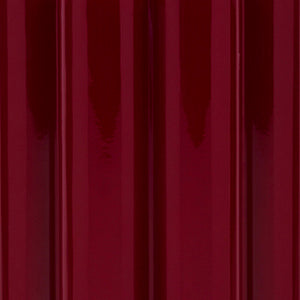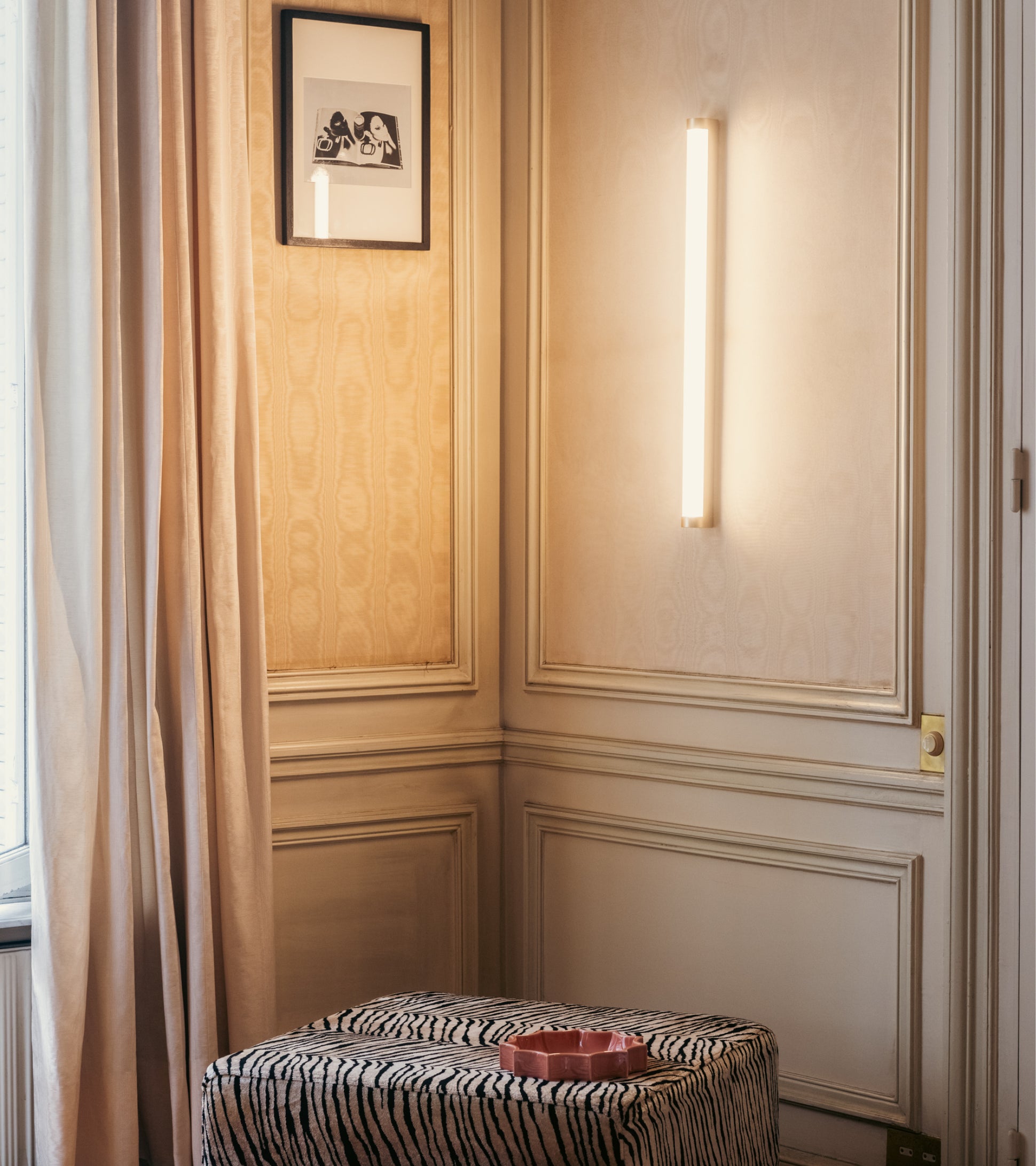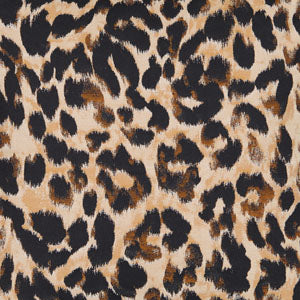Family
In the heart of Belleville, the light-filled cocoon of a rising architect and the chef of a Parisian institution
At
Camille Marchal, Anthony Salomon and Léo, 9 months
Who hasn’t heard a disappointed American tourist when they stumble across a neighborhood long celebrated in Paris? For centuries, songs have praised the arrondissements of the capital, from the Champs-Élysées to Parc Montsouris, Ménilmontant to the Grands Boulevards. But Paris has this peculiarity — contrary to what the casual visitor might think, it doesn’t always reveal itself as immediately as the Palais Royal or a stately building in Saint-Germain-des-Prés. The city teems with hidden corners, where happiness tucks itself away in a tiny restaurant, at the back of a boutique long sought out, or down an alley branching off a grand avenue.
Belleville is one of those neighborhoods where life’s energy is felt rather than seen. You could easily miss it if you only passed through. Camille and Anthony are true children of Belleville. Like many genuine Parisians, they hail from elsewhere but have adopted the area with fierce devotion. Anthony Salomon is the chef at the much-talked-about restaurant Le Dauphin, its marble-clad interior dreamed up by architect Rem Koolhaas. He swears by Belleville’s hole-in-the-wall spots where, he insists, he finds much of his daily inspiration. Camille is an architect and interior architect with her own practice, Alors Studio, co-founded in 2019. We followed her through the streets of Belleville, which she knows by heart, zipping along with her stroller from the family apartment to the restaurant — and even to a few of her favorite local haunts. But first, we met them over coffee with baby Léo, in the bright cocoon Camille redesigned for their family.
Location
Paris
Author
Elsa Cau
Photos and videos
Valerio Geraci, Gautier Billotte
TSF
Camille, Anthony, who are you?
Camille
I’m an architect. I co-founded Alors Studio with Baptiste Fleury in 2019. I was born in Bourgoin-Jallieu, in Isère. At school, I liked the idea that “architecture isn’t that serious.
Anthony
Je suis né à Nice. Je suis chef du restaurant Le Dauphin, avenue Parmentier à Paris. Nous sommes les parents de Léo, la huitième merveille du monde.
TSF
What’s your background?
Camille
I graduated as a State-Certified Architect from the École Nationale Supérieure des Beaux-Arts (Paris-Malaquais) in 2013, after also spending time in Rome at La Sapienza and in London at South Bank University in 2010. The following year, I earned my HMONP certification at Malaquais — a qualification that allows State-Certified Architects to take full legal responsibility for a project in their own name.
After that, I worked in London at a practice called Brisac Gonzalez. Back in Paris, I joined a very small firm focused on interior renovations, before moving on to Bruther. And in 2019, I co-founded Alors Studio with Baptiste Fleury.
Anthony
When I arrived in Paris at 21, I first worked in the perfume industry. I spent five or six years as a product developer for luxury houses. It’s a fascinating job, touching so many things, but it’s also quite political. I wanted to get back to something more essential. Running a restaurant was always in the back of my mind. Of course, I cooked for friends and was always the one in charge of groceries on vacation, but I hadn’t realized just how deep my passion ran. At 28, I retrained, got my CAP diploma in cooking — just to know what I was getting into. Then I did an internship at Le Dauphin. It was love at first sight, both with the place and with the profession. The way the kitchen was set up, the energy, the dishes flying out — somewhere between tapas and tradition — that little restaurant doing so much really challenged me.
TSF
And so you stayed on at Le Dauphin, Anthony!
Anthony
I did. I even spent lockdown there. We were very active during that time. We helped at Le Châteaubriand (just down the street), opening a takeaway pizzeria. And at Le Dauphin, we served up little Belleville-style ravioli, broths, daily dishes. I learned a lot. Even psychologically, that strange lockdown bubble gave me a freer way of learning to cook, without the usual pressure. Because when you start out, cooking is a painful apprenticeship. That period gave me real confidence. I started as sous-chef, and three or four years later I became head chef. It’s been just over two years now.
TSF
How would you describe your cooking?
Anthony
It’s always hard to describe. Cooking depends on your mood, the weather, the produce. “For me, it’s a language, a way of expressing what I feel, a real form of communication. I usually find it hard to talk to people. Cooking is a real connection.”
Mine is very Mediterranean — the South, where I come from. I love spices, Italian and North African influences, the broader Mediterranean basin. Nice was always so connected to all of that.
Belleville, where I live and work, inspires me hugely. I eat a lot of Asian food — Sichuanese, Chinese, Japanese. My team also inspires me. I’ve just hired a Japanese chef who brings new influences, new products, new ways of seasoning. My sous-chef is Portuguese and came with his whole knowledge of cuisine — his fish stew with rice, for example. That sparks ideas, leads to new recipes. That’s how we work: nothing written down, constant renewal. Except for a few emblematic Dauphin dishes, nothing is ever repeated.
TSF
Camille, you co-founded Alors Studio.
Camille
Yes, with Baptiste Fleury, who’s also a close friend. We met while working at Bruther, on big competition projects. It was an intense period. Starting our own practice, we were thrilled to reconnect with small-scale projects, details — and above all, with real clients who would live in what we designed for them.
TSF
Do you have a signature style at Alors Studio?
Camille
Above all, we have a real passion for floor plans — especially the sketching phase, when we move things around endlessly until the layout works and the client can picture themselves in it. We spend a lot of time there. Material choices then flow quite naturally: we like contrasts between raw and noble materials, and rarely work with anything short-lived. In that sense, we’re quite traditional.
When we were younger, both of us lived in London, fascinated by Brutalist architecture — I guess that left a mark. But we’re open-minded! We like when clients impose constraints that push us to rethink things. That’s interesting. Another key point: we’re both certified HMONP architects, so we can build, not just design.
TSF
What are you working on at the moment?
Camille
In interiors, we’d like to move more towards collaborations, especially with young designers. We’re renovating a house, currently in the construction phase, and we have various apartment, boutique, and restaurant projects under study. We’ll also soon deliver a new office space in Paris.
Custom central furniture piece, designed by Alors Studio
Vintage ashtray, found piece.
Vintage S33 cantilever chair by Mart Stam for Thonet.
Sammode neon tube.
Chairs, Alu Chair model by Muller van Severen for Valérie Objects.
Sintesi lamp by Ernesto Gismondi for Artemide.
TSF
Anthony, your latest discovery?
Anthony
Just last week I came up with a little recipe I really liked: pasta alle vongole with cockles and a rocket pesto made with mussel juice. It worked beautifully, topped with a bit of parmesan at the end. Which is, of course, forbidden in Italy.
TSF
What kind of environment did you grow up in, and how did it shape your tastes?
Camille
I grew up near Lyon, and my family is from the Annecy and Évian-les-Bains region. I adore those places, I’m deeply attached to them. In Haute-Savoie, architect Maurice Novarina (1907–2002) built, among other things, a swimming pool in Évian that has always influenced me — I think I’ve unconsciously borrowed many of its elements. My parents were always dragging us to museums. They loved art, the Pre-Raphaelites, Caravaggio… I think they were both delighted when I went into architecture. They always supported me, even though I didn’t come from that world at all.
Anthony
My family is of Italian origin. My father owned a restaurant. I was born in Nice and grew up in Saint-Paul-de-Vence. We lived in the countryside, with horses as neighbors. Arriving in Paris, I was amazed to be in such a big city, with everything at your fingertips. Of course, I missed the sea and the sun. I still do. But now I couldn’t live without Paris and its energy. Plus, Paris has a wonderful restaurant community — we all know each other, respect each other, and that’s a joy. And here in Belleville, I eat the best food. Ninety percent of my free time is spent in its restaurants.
TSF
What did you fall in love with right away, when you moved here?
Camille
First, I was determined to find a 1970s apartment. I’d had enough of old Haussmann places — beautiful but so impractical! I work a lot on those for clients, and they always come with nasty surprises: tricky layouts, damp issues, wasted space. I wanted light above all, and something simple, functional.
When we arrived here four years ago, I loved the scale of this small building — human-sized, not a big slab block. We get along wonderfully with our neighbors. It feels like a real community. I love the modest façade; the codes of that era are charming. Inside, nothing was like it is now. But we fell in love with the big pivot windows, which became our starting point. We thought: “Let’s just make one big room, with an open plan.”
TSF
Did you do much work?
Camille
We stripped everything back to nothing. Completely redesigned the layout. Now the circulation is simple: you enter straight into the main living space, and everything happens there — entrance, kitchen, living room, storage. Before, it was a typical ’70s flat: tiny kitchen, long entry hallway, endless corridors and partitions squeezed into a small space (laughs). The mosaic parquet too — we replaced it with a sanded and varnished self-leveling screed.
It was partly an economic choice, but I also loved the raw, industrial look for flooring. I’m not a big fan of polished concrete — it’s too smooth, it ages badly. The screed is more irregular, warmer. And I liked the idea of one continuous floor, the same surface everywhere, no transitions.
TSF
What atmosphere did you want to create at home?
Camille
When we moved in, we weren’t parents yet… so now we’ve got a small problem with the bedroom situation we’ll have to solve sooner or later (laughs). Anthony really trusted me. He only had one or two priorities, like the kitchen. Otherwise, he let me take the lead on the project and the materials. It was really smooth — a pleasure.
The project itself is simple. It comes to life through objects, furniture, drawings, photographs. I love our little balcony too — even though it’s awkwardly placed off the bedroom, we actually use it a lot, especially for reading. It’s a little pocket of pleasure.
TSF
Anthony, the kitchen was your priority.
Anthony
Yes, I wanted something as close as possible to a professional kitchen. So it’s all stainless steel. And I insisted on gas burners — I’d never had them at home before. Gas gives you real freedom. With flame, you can cook in three dimensions: play with height, depth — something you can’t do with ceramic or induction, where the pan has to sit flat to get heat. It’s a different experience: the look, the sound, the fire.
Otherwise, I don’t have many gadgets. I think you can cook with very little — a pot, a pan, a knife. At Le Dauphin it’s another story, but at home that’s enough. I make simple dishes, but good ones.
TSF
More generally, are you sensitive to the décor around you?
Anthony
I think we don’t express the same thing depending on the setting we’re in. If I worked in an old bistro, maybe I’d make warmer, heartier dishes. Here, maybe the space pushes me toward cleaner lines, sharper visuals. It’s unconscious — we don’t design dishes that way — but I do believe the place and the energy it gives off influence the cooking. I wouldn’t work the same way in another restaurant.
TSF
Your apartment is 60 m². I imagine storage was an issue — the eternal battle in small Paris flats…
Camille
Of course! Both walls, from the entry through to the living space, are lined with built-in storage that runs the whole length. In the bedroom too, there’s a large closet; in the bathroom, hidden cupboards everywhere… For the size of the apartment, the amount of storage is impressive (laughs). I think we’re all a little traumatized by old rental flats with no storage. I’ve probably turned it into an obsession!
TSF
You still managed to create an entrance… without an entrance.
Camille
Instead of putting up a full-height partition to carve out an entryway in what is now the living space, we designed a super-functional piece of furniture. On one side, it holds all the shoes; on the living-room side, all the vinyls. It creates a sort of unconscious boundary. On the other side, a hallway forms naturally leading to the bathroom. It’s visually light, but you feel the separation.
TSF
Did you adapt your interior for the arrival of your child?
Camille
Not really. My nightmare was people walking in and immediately saying: “Oh, they’ve got a kid…” (laughs). We kept it minimal. No mountain of toys or gear. We try not to overconsume.
On the wall, a drawing by Martinet & Texereau.
The bedroom is now separated from the baby’s corner by this embroidered curtain, designed by Sophie Estève for Alors Studio.
On the stool by the bed, a Cobra lamp by Christian Koban.
In the baby’s room, a colorful drawing by Juliette Druelle.
The ceramic handles on the cupboards were designed by Camille Marchal and produced by Alors Studio.
"I think we don’t express the same thing depending on the setting we’re in."
TSF
Tell us about something you especially love at home.
Camille
There’s this photograph in the living room, taken by our friend Léon Prost. It was part of a feature for M Le Magazine du Monde on French florists — it shows tulips in Marseille. Anthony gave it to me. Right opposite, there’s a small drawing of a lemon by our friend Sophie Estève, who started showing her work in Paris this year. She mostly paints still lifes. We also worked with her on embroidery and fabric research for the curtain that now separates our room from Léo’s. It was a departure from her usual work, but we loved collaborating with her.
On the kitchen shelf, there’s a row of ceramics I made. I got really into it when I was pregnant, maybe to force myself to stay in more while Anthony was working evenings. I also made a series of ceramic handles, which we’ve used in agency projects — and here too, on some cupboard doors in the bathroom.
TSF
What are your favorite local spots?
Camille & Anthony
The Sunday market at Place des Fêtes — oysters in the sun with tower blocks in the background. Straight out of a movie. Lao Siam for shrimp fritters — we always order a second plate even when we promise ourselves we won’t. Chez Rori further down in Belleville, for its beauty, the perfect pizza slice, and of course to bump into Angela and Antoine. Right nearby, Les Œillets for a glass of wine at the counter with Solal and Max’s warm welcome. And just downstairs from us, Candle Kids for coffee and pastries (the lemon blueberry cake!), with a terrace we always end up on at some point during the weekend.
TSF
What does The Socialite Family mean to you?
Camille & Anthony
At first it was a media outlet, where we discovered stories and interiors. Through the Studio, it also became a tool for presenting and selecting furniture with our clients.
TSF
Do you have a favorite piece from our collection?
Camille & Anthony
Without hesitation: the
from the new
collection, in pale blue. The leg design combined with the glossy lacquer makes it a truly stunning piece.
Ceramic objects by Cindy Liao Rasamoelina and Camille Marchal. Red tiled shelf by Alors Studio.
Lemon drawing by Sophie Estève.
)
)
)
)
)
)
)
)
)
)
)
)
)
)
)
)
)
)
)
)
)
)
)
)
)
)
)
)
)
)
)
)
)
)
)
)
)
)
)
)
)
)
)
)
)
)
)
)
)
)
)
)
)
)
)
)















































)